Choosing the best materials for kitchen sinks involves balancing durability, aesthetics, and maintenance. Stainless steel is popular for its cost-effectiveness and versatility, with 16-18 gauge being ideal for durability. Cast iron sinks offer a classic look and robustness but are heavy and prone to chipping. Granite composite sinks are durable and stylish, though they can crack under heavy impact. Fireclay sinks are high-end and scratch-resistant but expensive. Copper sinks add rustic charm and antimicrobial properties but need regular upkeep. Quartz composite sinks are durable and hygienic, though installation issues can arise. Solid surface sinks provide a seamless look but are less heat-resistant. Porcelain sinks offer a glossy finish but can chip easily. Each material has unique pros and cons, so choose based on your kitchen’s needs and style. For more detailed information on choosing the best kitchen sink, check out The Ultimate Guide to Choosing the Best Kitchen Sink.
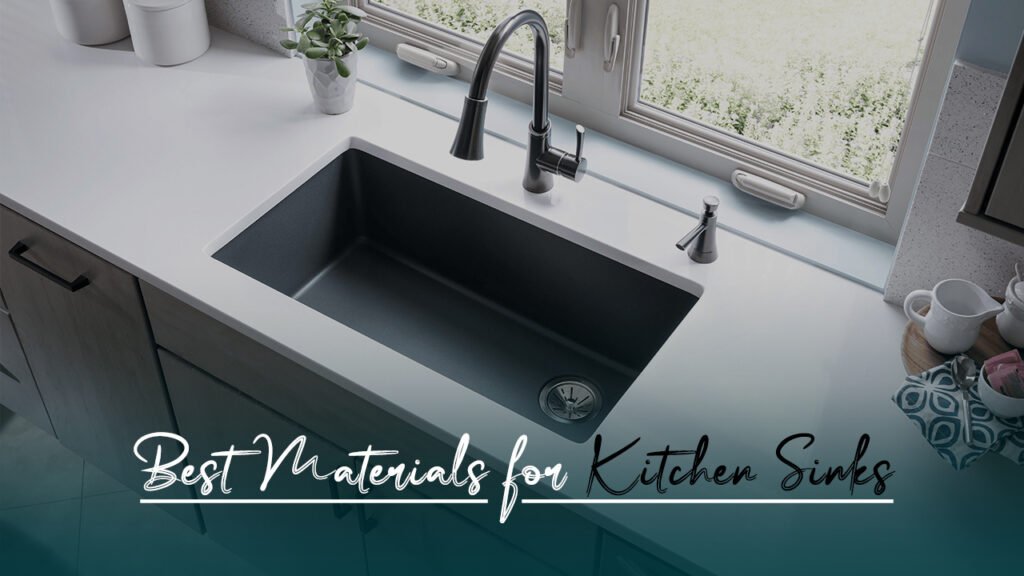
1. Stainless Steel: Kitchen Sink Materials
Stainless steel sinks are made from an alloy of steel containing chromium, providing rust and corrosion resistance. They come in various thicknesses, measured in gauge; a lower gauge means thicker and more durable steel.
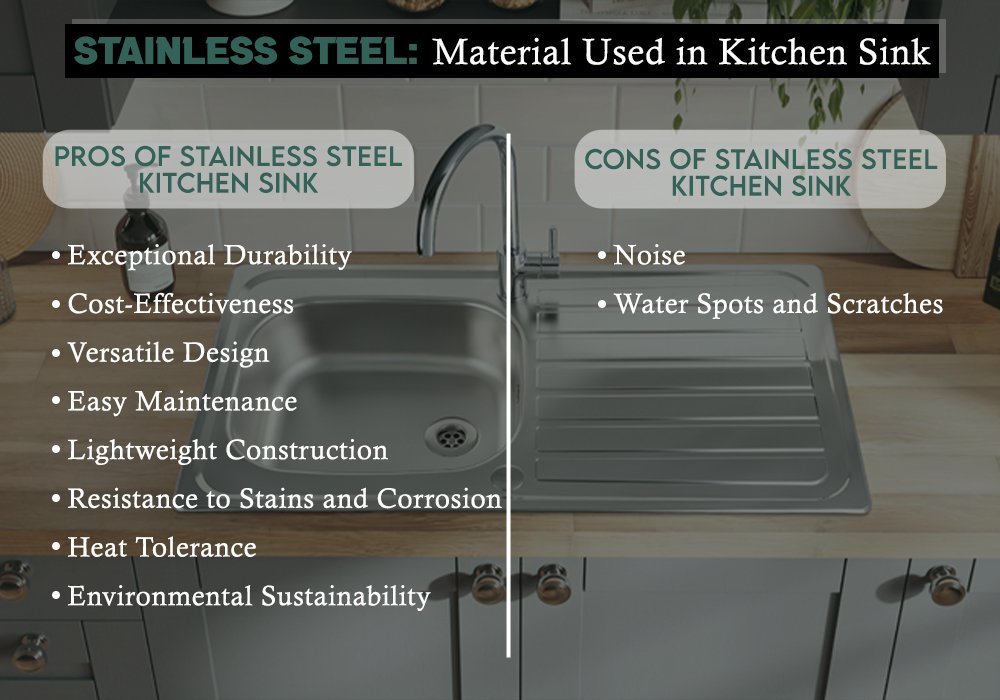
Pros of Stainless Steel Kitchen Sink
When considering the best materials for kitchen sinks, stainless steel emerges as a top contender due to its numerous advantages:
- Exceptional Durability: Stainless steel sinks are renowned for their robustness. They resist chipping, cracking, and high temperatures, making them one of the most durable choices for busy kitchens.
- Cost-Effectiveness: Offering a wide range of prices, stainless steel sinks are accessible to various budgets. This affordability doesn’t compromise quality, making them a cost-effective option among the best materials for kitchen sinks.
- Versatile Design: Stainless steel’s sleek, modern look complements a variety of kitchen styles, from contemporary to industrial. Its neutral appearance ensures it blends seamlessly with other kitchen elements.
- Easy Maintenance: The smooth surface of stainless steel is easy to clean and sanitize, helping maintain a hygienic kitchen environment. It’s less likely to harbor bacteria, making it a practical choice for cleanliness.
- Lightweight Construction: Compared to heavier materials like cast iron or granite composite, stainless steel sinks are lightweight. This simplifies installation and places less strain on kitchen cabinetry.
- Resistance to Stains and Corrosion: The chromium content in stainless steel provides excellent resistance to rust, stains, and corrosion, ensuring the sink retains its attractive appearance over time.
- Heat Tolerance: Stainless steel sinks can handle high temperatures, allowing you to place hot pots and pans directly in the sink without causing damage.
- Environmental Sustainability: Stainless steel is 100% recyclable, making it an eco-friendly choice for those looking to minimize their environmental impact. Choosing stainless steel aligns with sustainable practices.
In summary, stainless steel sinks offer a blend of durability, cost-effectiveness, and ease of maintenance, solidifying their position among the best materials for kitchen sinks. Whether you prioritize longevity, ease of cleaning, or a versatile design, stainless steel is a reliable and practical choice for any kitchen.
Cons of Stainless Steel Kitchen Sink
- Noise: It can be noisy, though many modern sinks include sound-absorbing pads.
- Water Spots and Scratches: Prone to showing water spots and scratches; needs regular cleaning to maintain appearance.
Considerations:
- What gauge of stainless steel sink is best? Generally, 16-18 gauge is recommended for durability.
2. Cast Iron (Enameled)
Cast iron sinks are coated with a layer of enamel (porcelain). They are known for their classic and robust appearance.
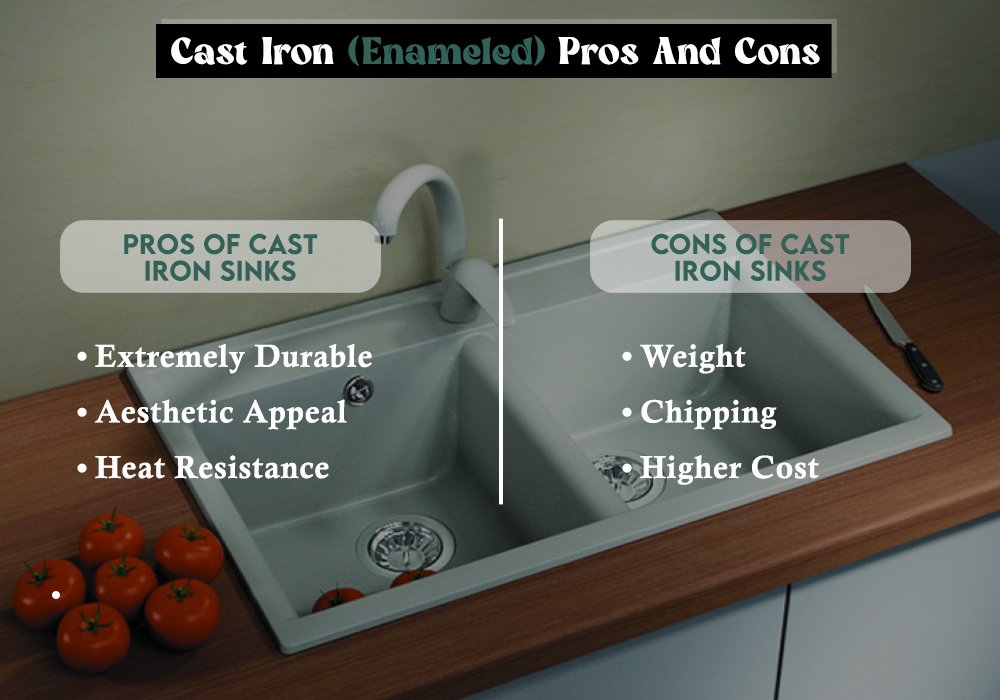
Pros of Cast Iron
When evaluating the best materials for kitchen sinks, cast iron stands out due to its unique blend of durability, aesthetic appeal, and heat resistance. Here are the pros and cons of cast iron sinks:
- Extremely Durable: Cast iron sinks are incredibly durable, capable of withstanding heavy use and lasting for decades. This longevity makes them a top choice among the best materials for kitchen sinks.
- Aesthetic Appeal: With a glossy, high-end look available in various colors, cast iron sinks add a touch of elegance and sophistication to any kitchen. Their timeless appeal enhances the overall kitchen design.
- Heat Resistance: Cast iron sinks can handle hot pots and pans directly from the stove without sustaining damage. This heat resistance is a significant advantage, making them highly practical for everyday cooking and kitchen tasks.
Cons of Cast Iron Sinks
- Weight: Cast iron sinks are very heavy, often requiring reinforced cabinetry to support their weight. This can complicate installation and may necessitate additional structural support.
- Chipping: The enamel coating on cast iron sinks can chip if heavy objects are dropped on it, exposing the iron underneath to potential rust. This susceptibility to chipping requires careful handling and maintenance.
- Higher Cost: Cast iron sinks are generally more expensive than other materials like stainless steel. While their durability and aesthetic appeal justify the cost for many homeowners, they may not fit all budgets.
In conclusion, cast iron sinks offer exceptional durability, heat resistance, and aesthetic appeal, making them one of the best materials for kitchen sinks. However, their heavy weight, potential for chipping, and higher cost are important considerations when choosing the ideal sink material for your kitchen.
Maintenance:
- Cleaning Cast Iron Sink: Regular cleaning and avoiding harsh abrasives can maintain its look.
- Re-enamel sink: Professional re-enameling can restore chipped areas.
3. Granite Composite
When selecting the best materials for kitchen sinks, granite composite stands out due to its unique blend of durability and aesthetic appeal. Granite composite sinks are made from a mix of crushed granite stone and resin, resulting in a solid, uniform appearance. Here are the pros and cons of granite composite sinks:
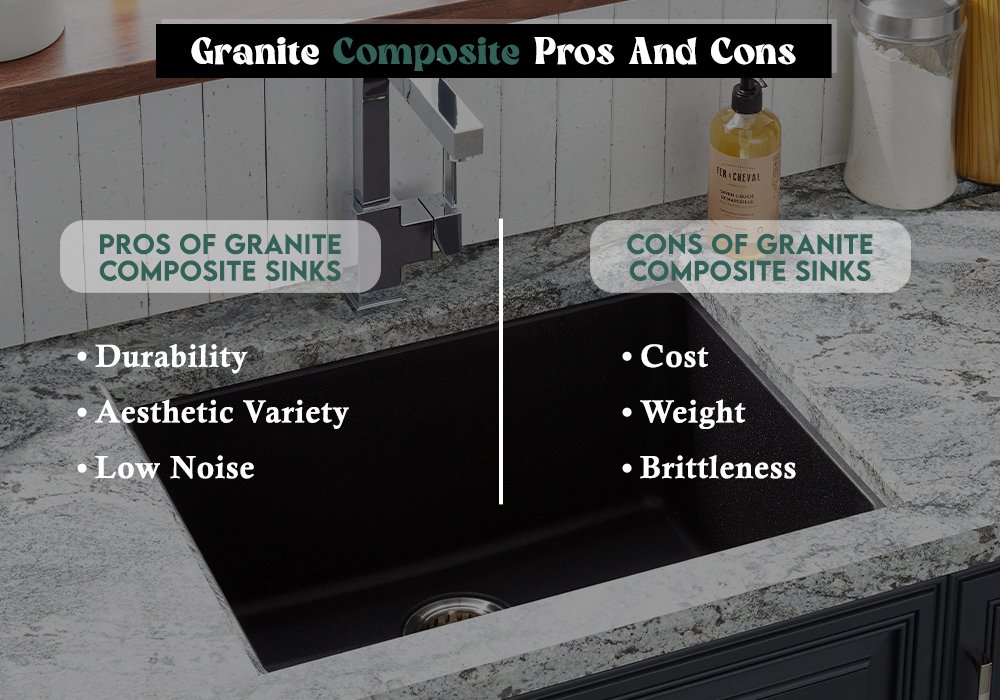
Pros of Granite Composite Sinks
- Durability: Granite composite sinks are highly resistant to scratches, stains, and heat. This durability makes them one of the best materials for kitchen sinks, capable of withstanding daily wear and tear.
- Aesthetic Variety: Available in various colors and finishes, granite composite sinks offer a wide range of aesthetic options to complement different kitchen designs. Their stylish appearance adds a touch of elegance to any kitchen.
- Low Noise: These sinks are naturally sound-absorbing, which reduces noise from dishes and running water. This feature enhances the overall kitchen experience by minimizing disruptive sounds.
Cons of Granite Composite Sinks
- Cost: Granite composite sinks are generally more expensive than materials like stainless steel and porcelain. While their durability and aesthetic benefits justify the higher cost for many, they may not be the most budget-friendly option.
- Weight: These sinks are quite heavy, requiring strong support and potentially complicating installation. Reinforced cabinetry is often necessary to accommodate their weight.
- Brittleness: Despite their overall durability, granite composite sinks can crack or chip under heavy impact. This brittleness necessitates careful handling and installation.
Problems with Composite Sinks
- Potential for Cracking: Granite composite sinks can crack under severe impact or if not properly installed. Ensuring proper installation and handling can mitigate this risk, but it remains a concern for some homeowners.
In conclusion, granite composite sinks offer a durable, aesthetically versatile, and sound-absorbing option, making them one of the best materials for kitchen sinks. However, their higher cost, weight, and potential brittleness are important factors to consider when choosing the ideal sink material for your kitchen.
4. Fireclay
When evaluating the best materials for kitchen sinks, fireclay stands out for its combination of timeless beauty and robust functionality. Fireclay sinks are crafted by molding ceramic clay and firing it at high temperatures, resulting in a dense, durable material. Here are the pros and cons of fireclay sinks:
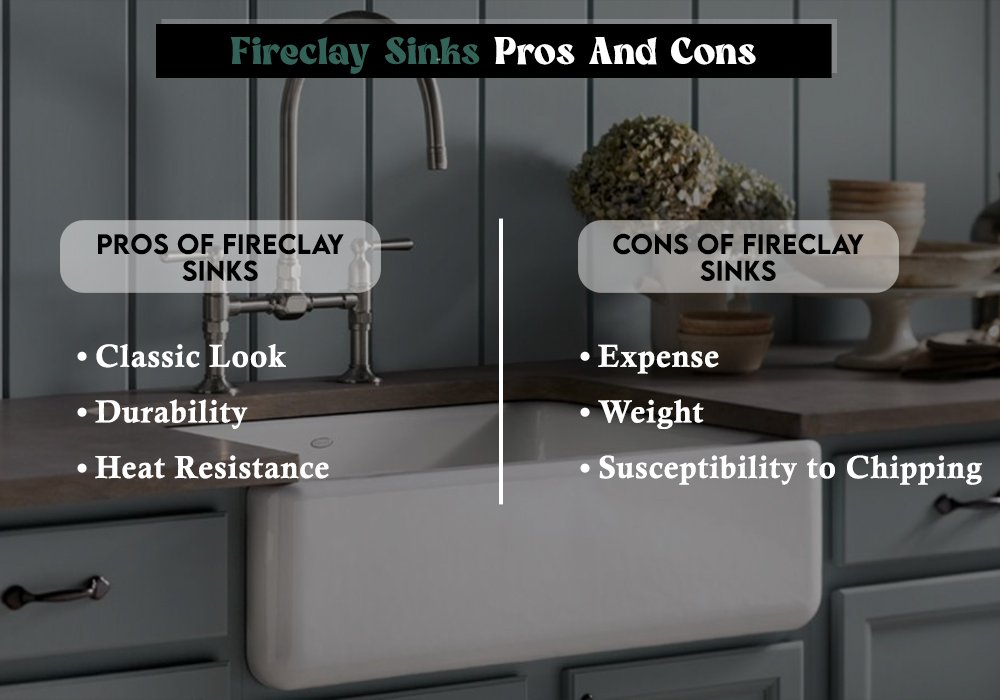
Pros of Fireclay Sinks
- Classic Look: Fireclay sinks offer a timeless, high-end appearance that enhances the aesthetic appeal of any kitchen. Their glossy, smooth finish adds elegance and sophistication.
- Durability: These sinks are highly resistant to scratches, stains, and acids, making them one of the best materials for kitchen sinks. Their robust nature ensures they can withstand daily kitchen use.
- Heat Resistance: Fireclay sinks can handle high temperatures without sustaining damage. This makes them ideal for dealing with hot pots and pans directly from the stove.
Cons of Fireclay Sinks
- Expense: Fireclay sinks are among the more costly sink options. Their high-end material and craftsmanship contribute to their higher price point, which might not fit all budgets.
- Weight: These sinks are heavy and require sturdy installation support. Reinforced cabinetry and professional installation are often necessary to accommodate their weight.
- Susceptibility to Chipping: Despite their durability, fireclay sinks can chip or crack if struck hard. Careful handling and avoiding heavy impacts are essential to maintain their integrity.
Comparison
- Fireclay vs. Cast Iron: Both materials are durable and heat resistant. However, fireclay is more resistant to acids and scratches compared to cast iron, which can chip and expose the iron to rust.
- Fireclay vs. Porcelain Sink: Fireclay is generally tougher and more resistant to impacts than porcelain. While both offer a similar glossy finish, fireclay’s enhanced durability makes it a superior choice for high-traffic kitchens.
In conclusion, fireclay sinks offer a blend of classic elegance, durability, and heat resistance, making them one of the best materials for kitchen sinks. Their higher cost, weight, and susceptibility to chipping are important considerations, but their overall benefits make them a compelling option for those seeking both style and functionality in their kitchen.
5. Copper
Explanation: Copper sinks are made from sheets of copper, often hammered for texture. They develop a unique patina over time, adding to their character.

Pros of Copper
- Antimicrobial: Naturally kills bacteria, providing a hygienic surface.
- Unique Look: Develops a beautiful patina with age, adding character.
- Heat Resistance: Handles hot cookware well.
- Aesthetic Appeal: Distinctive and attractive but requires more maintenance.
Cons of Copper
- Expense: Generally quite expensive.
- Maintenance: Requires regular polishing to maintain shine and prevent tarnish.
- Dents and Scratches: Softer metal prone to dents and scratches.
6. Quartz Composite
Explanation: Quartz composite sinks are made from a blend of natural quartz stone and resin, offering a durable and attractive finish.
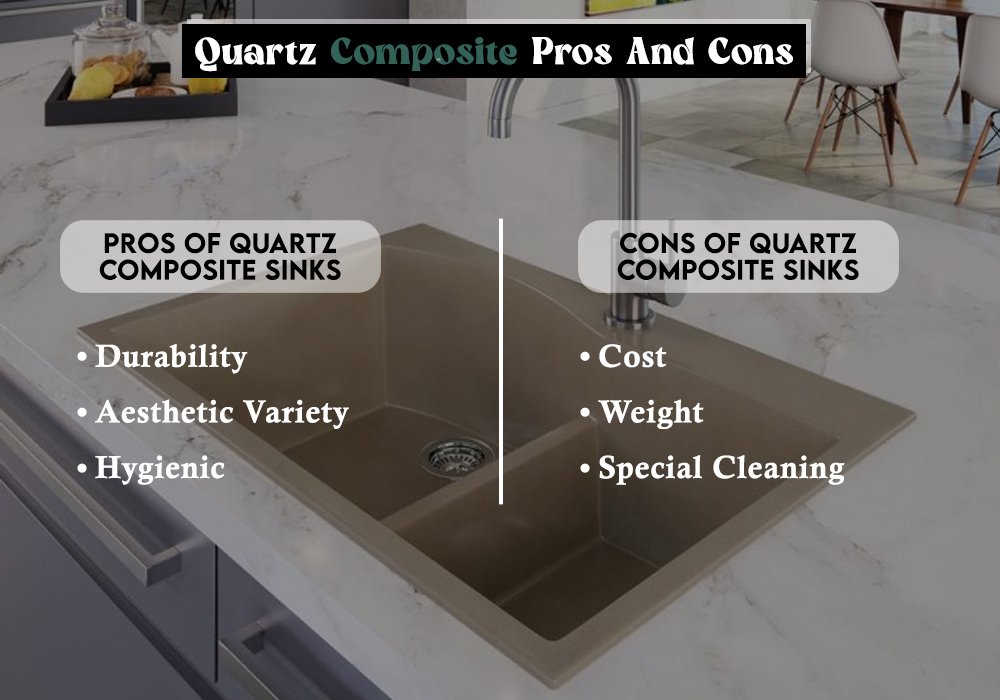
Pros of Quartz Composite
- Durability: Highly resistant to scratches, stains, and heat.
- Aesthetic Variety: Available in a wide range of colors and styles.
- Hygienic: Non-porous surface prevents bacteria growth.
Cons of Quartz composite
- Cost: Can be quite expensive.
- Weight: Heavy, requiring robust cabinetry.
- Special Cleaning: May need specific cleaners to avoid surface damage.
Issues:
- Quartz Composite Sink Problems: While durable, improper installation or impact can lead to cracks.
7. Solid Surface
Solid surface sinks are made from a blend of acrylic and polyester resins, often integrated seamlessly with countertops.
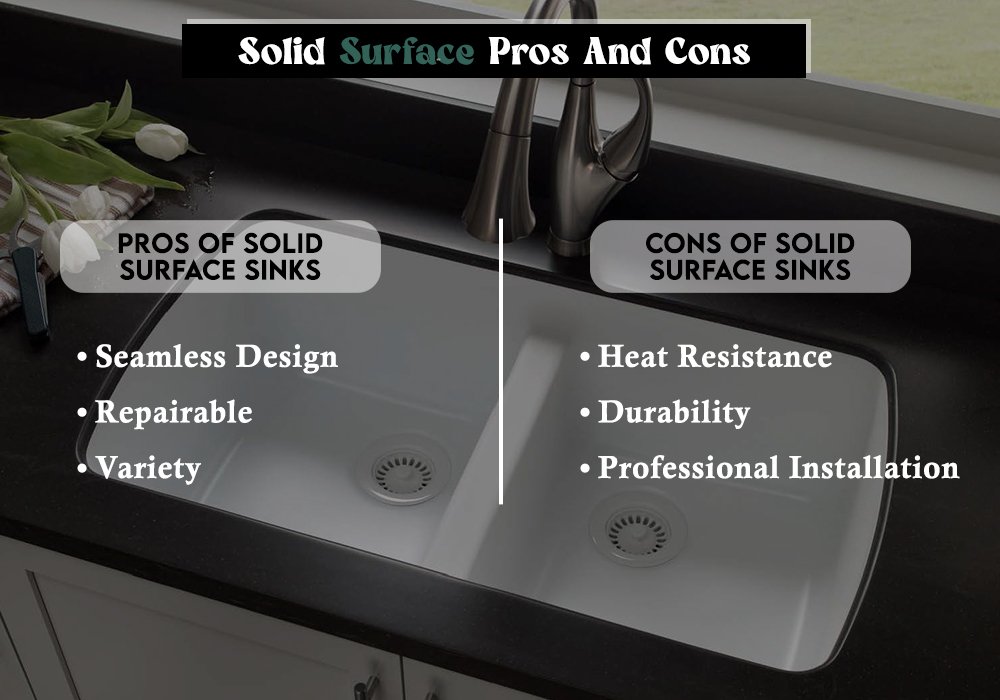
Pros of Solid Surface
- Seamless Design: Integrated with countertops for a smooth, continuous look.
- Repairable: Scratches and minor damage can be sanded out.
- Variety: Available in numerous colors and patterns.
Cons of Solid Surface
- Heat Resistance: Less resistant to high temperatures compared to stone or metal sinks.
- Durability: Can scratch and dent more easily than harder materials.
- Professional Installation: Often requires professional installation for best results.
8. Porcelain (Ceramic)
Porcelain sinks are made from ceramic materials fired at high temperatures to create a hard, glossy surface.
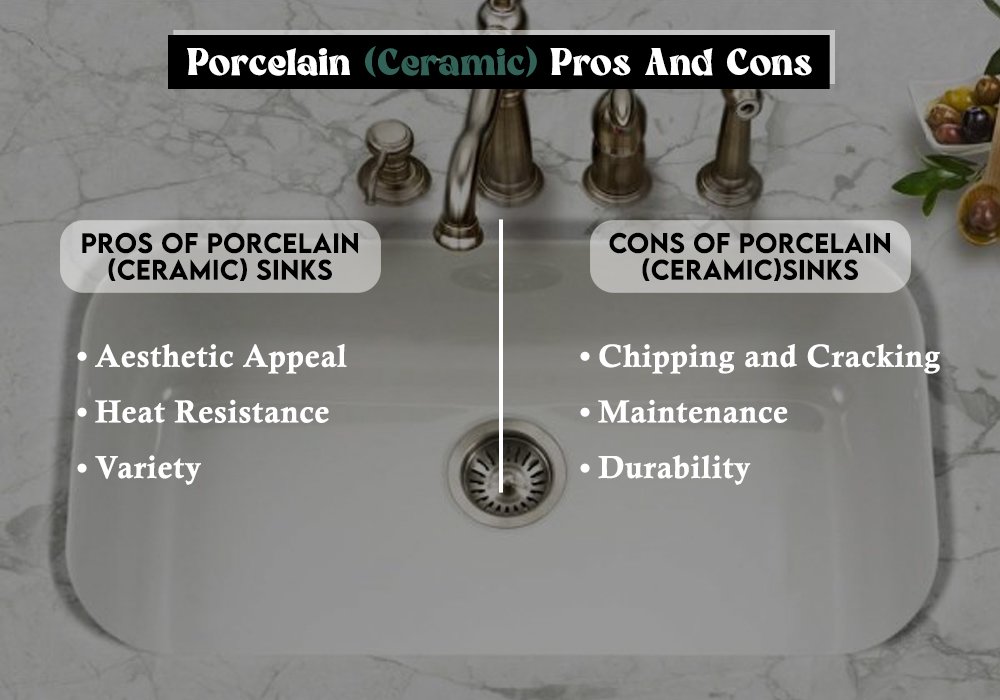
Pros:
- Aesthetic Appeal: Smooth, glossy finish with a classic look.
- Heat Resistance: Can handle hot pots and pans.
- Variety: Available in various colors.
Cons:
- Chipping and Cracking: Can chip or crack if heavy objects are dropped.
- Maintenance: Requires regular cleaning to maintain its glossy appearance.
- Durability: Not as durable as stainless steel or granite composite.
Comparison:
- Porcelain vs. Fireclay Sinks: Fireclay is more durable and less prone to chipping than porcelain.
Choosing the Right Material
The best type of kitchen sink material will depend on your specific needs and preferences. Consider the following when making your decision:
- Durability: If you need a sink that will withstand heavy use, materials like stainless steel, granite composite, and fireclay are good options.
- Aesthetics: Choose a material that complements your kitchen’s design. For example, stainless steel works well in modern kitchens, while fireclay and porcelain are great for traditional or farmhouse styles.
- Maintenance: Consider how much time you’re willing to spend on upkeep. Materials like stainless steel and granite composite are relatively low-maintenance, while copper and porcelain may require more care.
- Budget: Balance your desired features with what you can afford. Stainless steel tends to be more budget-friendly, while materials like fireclay and copper are on the higher end.
Additional Considerations
- Farmhouse Sink Pros and Cons: These sinks offer a large basin and a stylish look but are often more expensive and require custom cabinetry.
- Pros and Cons of Garbage Disposal: While convenient for food waste, they require proper maintenance and may not be compatible with all sink materials.
- Future Kitchen Sink Trends: Innovative materials and integrated technology are shaping the future of kitchen sinks.
Conclusion
Choosing the best material for a kitchen sink depends on various factors including durability, maintenance, aesthetic appeal, and budget. Stainless steel remains a popular choice due to its resistance to stains, ease of maintenance, and sleek look. Granite and composite sinks offer excellent durability and an elegant appearance but can be more expensive. Porcelain and ceramic sinks provide a classic, timeless look, though they might be more prone to chipping. Each material has its unique benefits, so it’s essential to consider your kitchen’s needs and your lifestyle to make the best choice. Ultimately, investing in a quality sink that suits your preferences and usage will enhance both the functionality and style of your kitchen.
